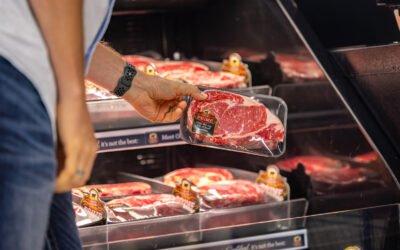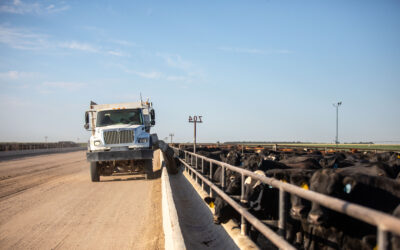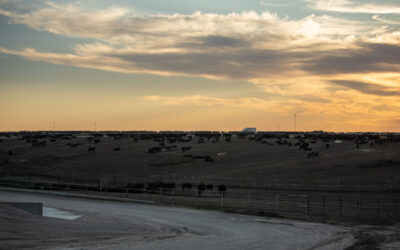
Stocker strategies affect value
by Steve Suther
There was a time when corn was $3 per bushel and finished cattle were clocking in at younger and younger ages, that the stocker phase may have seemed less important. Nobody would say that, after a decade of increasing feed prices for fewer calves that finish at ever higher weights.
An estimated 76% of calves spend some time as stockers, and since marbling is a lifetime event, what happens then plays a key role in subsequent beef quality grade after finishing.
A white paper for Certified Angus Beef LLC (CAB) entitled, “Effects of nutrition and management during the stocker phase on quality grade,” evaluates the body of research in the area and finds pathways to profit that maintain consumer satisfaction.
The Oklahoma State University animal science and veterinary team led by ruminant nutritionist Clint Krehbiel sees the potential for increasing efficiency and carcass quality. It might just take a few critical changes in management “during early phases of the production cycle that increase intramuscular fat (IMF) deposition” while decreasing other fat deposition.
While noting that net dollars depend on both carcass weight and quality, the paper focuses on stocker nutrition and management strategies that can impact marbling. On the related tangent, however, it also concludes that increasing carcass weight will increase marbling scores.
Of course, differences in calves start before the stocker phase, which must deal with the range of genetics, nutrition and health. In general, prior sickness leads to poorer average daily gain (ADG) en route to a lower value carcass.
The effects of bovine respiratory disease (BRD) have been studied in more detail, always showing “negative effects on carcass characteristics.” ADG is also compromised, but research shows that, except for those chronically infected, more days on feed help to recover carcass quality.
The white paper cites several studies that support deworming as a way to add weight and quality. Application in the feedlot to steers not dewormed on pasture added 49 pounds (lb.) of gain, but deworming on pasture added $33.75 per head to the stocker phase. Use in both the stocker and feedlot phases improved subsequent marbling score.

A 1984 study established that IMF fat cells prefer glucose for development while external fat grows with more acetate in the rumen. That led to Illinois work in the 1990s showing glucose from corn starch in creep feed and starting rations for early-weaned calves gives marbling a head start.
That’s especially true when calves are gaining below their genetic potential.
After a meta-analysis of 14 studies that compared dietary starch in backgrounding, Krehbiel’s team reports cattle grown with a high level of starch had higher ADG in the finishing phase, but no difference in efficiency or carcass quality compared to other cattle.
Studies of high-starch supplementation on grass may show a boost to final marbling score only for cattle that enter the grazing phase weighing more than 800 lb., or nearly two-thirds of their final, finished bodyweight. More studies are needed to confirm that, however.
The highest gains on grass lead to heavier placements on feed and heavier subsequent carcass weights. Adjusted for rib-fat thickness, marbling score was positively related to ADG, placement weight and carcass weight.
However, the same rib fat-adjusted analysis shows lower ADG over longer grazing periods can also achieve the heavier weights that generally boost marbling scores.
“Marbling scores can be improved by ‘making cattle bigger’ through increasing the rate of gain during the stocker phase,” but the paper concludes that also increases yield grades. “In contrast, rib fat-adjusted marbling score can be improved by using low to moderate rates of gain for longer grazing periods.”
In taking a look at DNA-assisted selection, the paper concludes those new tools carry the potential to “maintain or increase muscle growth (ribeye area), while at the same time improving carcass quality (marbling score).”
The complete paper is available online at https://cabcattle.com/research.
You may also like
CAB Sets Sales Records, Sees Historically High Brand Acceptance Rates
In an otherwise tough time in the beef business, sales and supply records have been a bright spot. The positive numbers mean that quality beef production has not let up, and beef demand is holding. Consumers have proven the value proposition: the good stuff is worth a little more money, for a better eating experience.
Feeding Quality Forum Dates Set Earlier in August
When you’re feeding cattle, it counts to keep track of every calf, pound and dollar. Beyond the event’s educational sessions, networking between segments of the beef supply chain is invaluable—from feeders and cow-calf operators to allied industry and university researchers.
Every Issue Has Its Moment
Progress happens when people are at the table, engaged and committed to action. With a vested interest in the industry’s future, CAB is leaning in on conversations surrounding evolutions in meat science.



